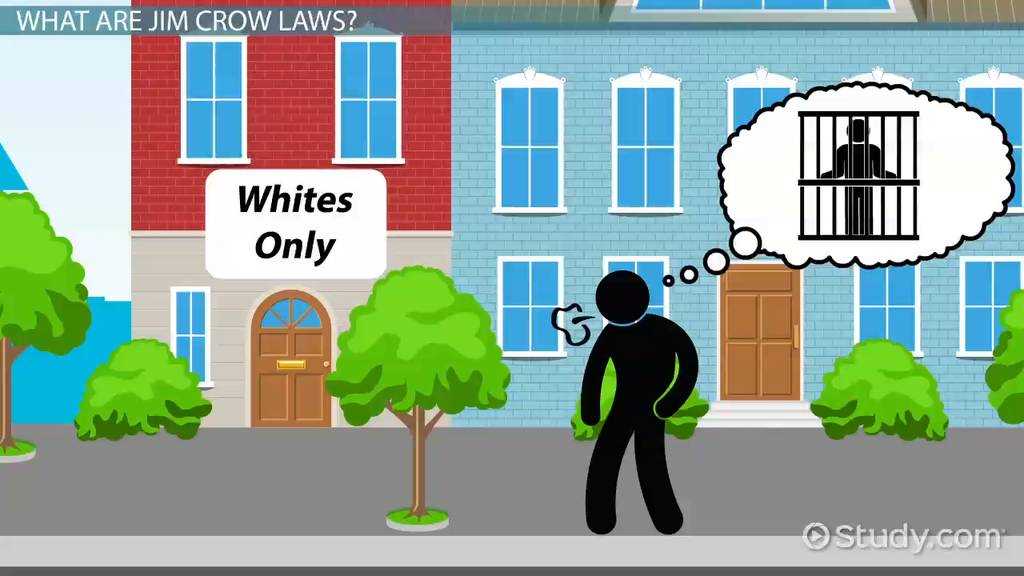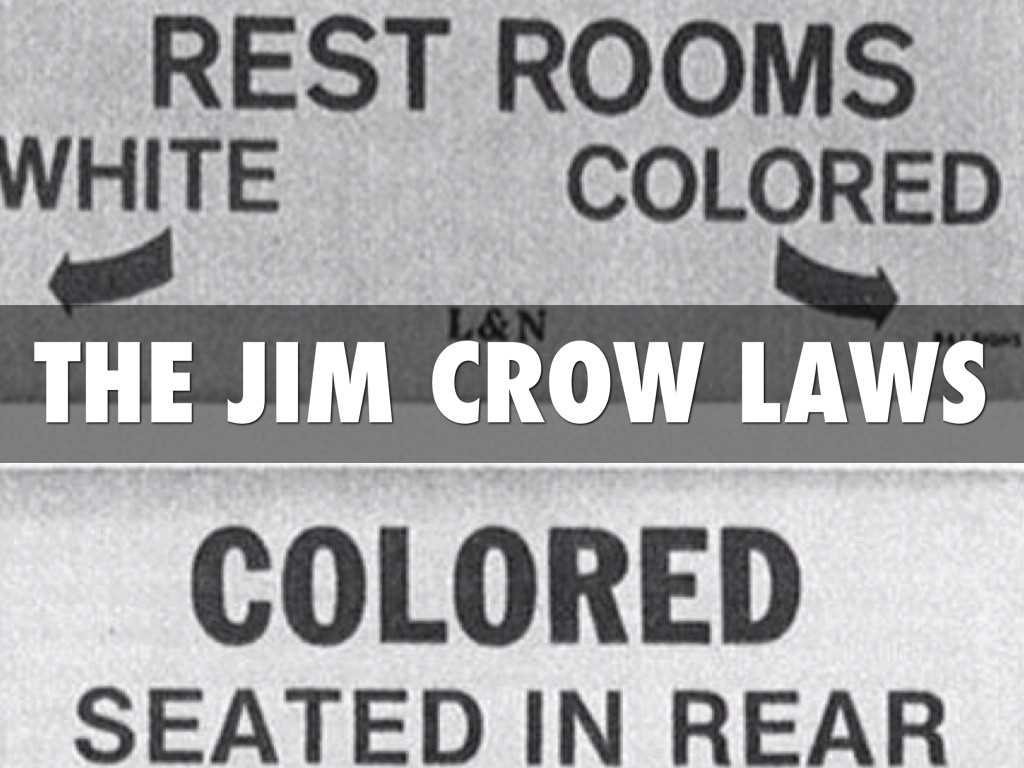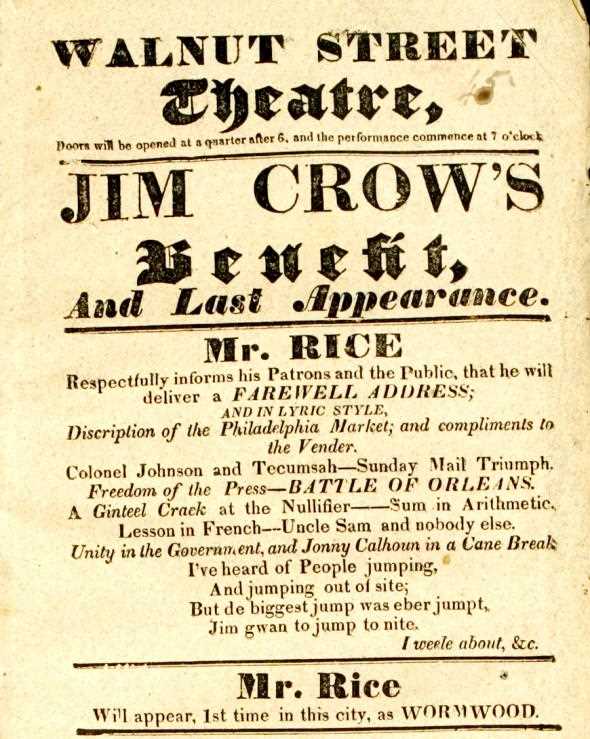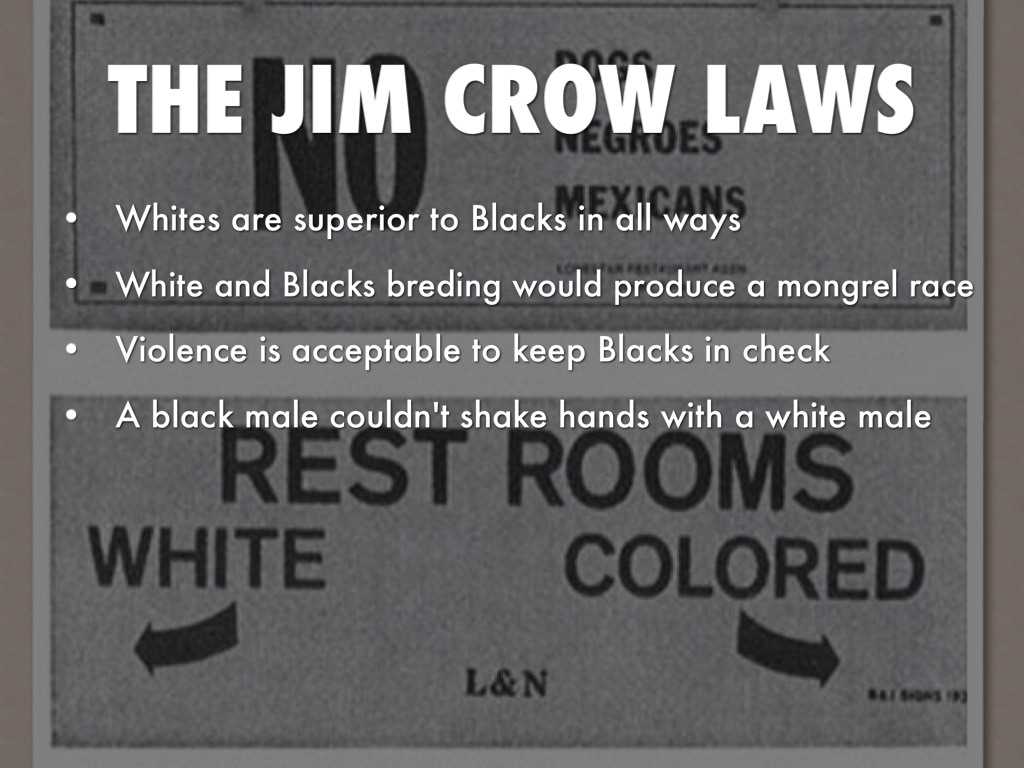
The Jim Crow laws were a series of state and local laws that enforced racial segregation in the Southern United States. These laws were enacted between 1876 and 1965 and were named after a popular minstrel character that depicted African Americans in a derogatory manner. The laws were designed to enforce racial hierarchy and maintain white supremacy.
The Jim Crow laws affected every aspect of life for African Americans. They mandated separate facilities for white and black individuals, including schools, transportation, housing, healthcare, and even cemeteries. African Americans were denied access to public spaces and were subject to discriminatory practices such as poll taxes and literacy tests that made it nearly impossible for them to vote.
This worksheet provides answers to questions related to the Jim Crow laws and their impact on African Americans. By understanding the history and legacy of these laws, we can better appreciate the struggle for civil rights and the ongoing fight against racism in America. It is important to learn from our past in order to create a more just and inclusive future.
Understanding Jim Crow Laws: A Comprehensive Worksheet Answer Key
The Jim Crow Laws were a series of state and local laws that enforced racial segregation in the United States, primarily in the South, from the late 19th century until the mid-20th century. These laws were implemented to maintain white supremacy and control over African Americans, depriving them of their civil rights and perpetuating racial discrimination and inequality.
1. What were Jim Crow Laws?
Jim Crow Laws were a system of laws enacted by Southern states in the late 19th and early 20th centuries that enforced racial segregation and discrimination. These laws mandated separate public facilities, such as schools, transportation, and restrooms, for white and black individuals. They also restricted African Americans’ access to public spaces, voting rights, and job opportunities.
2. How did Jim Crow Laws impact African Americans?
Jim Crow Laws had a profound impact on the lives of African Americans. These laws served to marginalize and oppress African Americans, denying them equal rights and opportunities. They created a segregated society in which African Americans were treated as second-class citizens, experiencing discrimination, violence, and limited economic and educational prospects. These laws reinforced racial stereotypes and hindered the progress and advancement of African Americans in society.
3. How did African Americans resist Jim Crow Laws?
African Americans used various strategies to resist the oppressive Jim Crow Laws. One of the most notable was the Civil Rights Movement, which encompassed nonviolent protests, boycotts, and legal challenges to challenge segregation and demand equal rights. African Americans also formed grassroots organizations, such as the National Association for the Advancement of Colored People (NAACP) and the Southern Christian Leadership Conference (SCLC), to advocate for racial equality and mobilize communities. Activists like Rosa Parks and Martin Luther King Jr. played crucial roles in the fight against Jim Crow Laws.
4. When and why did the Jim Crow Laws end?
The Jim Crow Laws began to weaken in the mid-20th century due to the efforts of civil rights activists and changing public opinion. The landmark Supreme Court case Brown v. Board of Education in 1954 declared that segregation in public schools was unconstitutional, challenging the legal basis of Jim Crow Laws. The Civil Rights Act of 1964 and the Voting Rights Act of 1965 further dismantled segregation and protected African Americans’ rights. While the formal legal framework of Jim Crow Laws was abolished, racial discrimination and inequality continue to persist in various forms in society today.
5. What lessons can we learn from the era of Jim Crow Laws?
The era of Jim Crow Laws serves as a powerful reminder of the consequences of institutionalized racism and the necessity of actively challenging and dismantling discriminatory systems. It highlights the importance of equal rights, justice, and inclusivity for all individuals. Understanding and learning from this period of history can help us address ongoing racial disparities and work towards building a more equitable society.
What Were Jim Crow Laws and When Were They Enacted?

The Jim Crow laws were a series of state and local laws that enforced racial segregation and discrimination in the United States, particularly in the Southern states, from the late 19th century until the mid-20th century. These laws were enacted primarily between the years of 1876 and 1965, with the majority of them being put into effect in the early 1900s.
Jim Crow laws came into existence after the Reconstruction Era following the Civil War. They were named after a racist caricature of a black man from a popular 19th-century minstrel show. The laws were designed to enforce racial hierarchy and preserve white supremacy by legally separating black and white Americans in all aspects of life, from education and transportation to housing and public facilities. They mandated separate schools, segregated seating on public transportation, and designated “whites-only” areas for recreation.
- Jim Crow laws varied by state, with some being more extreme than others. For example, in some states, interracial marriage was prohibited, while in others, there were restrictions on voting rights for African Americans.
- The Supreme Court’s landmark decision in 1896 in the case of Plessy v. Ferguson upheld the constitutionality of racial segregation under the “separate but equal” doctrine. This ruling provided a legal basis for the Jim Crow laws and allowed for the continued segregation of public facilities.
- It wasn’t until the Civil Rights Movement of the 1950s and 1960s that the Jim Crow laws began to be challenged and eventually overturned. The Brown v. Board of Education decision in 1954, which declared racial segregation in public schools unconstitutional, was a major turning point in the fight against Jim Crow laws.
The Jim Crow laws were a dark chapter in American history, reflecting the systemic racism and discrimination that persisted for many years. They had a profound impact on the lives of African Americans, perpetuating inequality and hindering their social and economic advancement. While these laws are no longer in effect, their legacy continues to shape the ongoing struggle for racial equality and justice in the United States.
Key Features and Segregation Practices Under Jim Crow Laws
Jim Crow laws were a series of racially discriminatory laws implemented in the United States between the late 19th and early 20th centuries. These laws enforced racial segregation and denied African Americans their civil rights. Some key features and segregation practices under Jim Crow laws include:
1. Separate Facilities
Under Jim Crow laws, facilities such as schools, public transportation, parks, and restrooms were segregated. African Americans and white individuals were required to use separate facilities, which were often of inferior quality for African Americans. This segregation aimed to reinforce the racial hierarchy and maintain white supremacy.
2. Racial Etiquette
Jim Crow laws imposed strict rules of racial etiquette that dictated how African Americans should interact with white individuals. African Americans were expected to address white individuals using titles like “Miss” or “Mister” and yield to white individuals on sidewalks. Failure to follow these rules could result in violence or legal repercussions.
3. Voting Restrictions
Jim Crow laws also targeted African American voting rights. Practices such as literacy tests, poll taxes, and grandfather clauses were implemented to disenfranchise African American voters. These restrictions were designed to suppress African American political power and ensure white domination in the voting process.
4. Employment Discrimination

Under Jim Crow laws, African Americans faced employment discrimination. They were often denied employment opportunities in white-owned businesses and relegated to low-wage jobs with limited opportunities for advancement. This systemic discrimination contributed to the economic disparity between African Americans and white individuals.
5. Segregated Education
Jim Crow laws enforced segregated education, with separate schools for African American and white students. African American schools were significantly underfunded and had fewer resources than white schools. This educational segregation perpetuated social and economic inequalities between African Americans and white individuals.
- Overall, Jim Crow laws were a comprehensive system of racial segregation that sought to oppress and marginalize African Americans. These laws were based on the belief in white supremacy and perpetuated racial inequality and discrimination across multiple aspects of society.
How Did Jim Crow Laws Affect African Americans?

Jim Crow laws were a system of state and local laws that enforced racial segregation in the United States, particularly in the Southern states, between the late 19th century and the mid-20th century. These laws had a profound and detrimental impact on African Americans, stripping them of their basic civil rights and perpetuating racial discrimination and oppression.
1. Limited Educational Opportunities: One of the main ways in which Jim Crow laws affected African Americans was through the restriction of educational opportunities. African American students were often forced to attend separate and poorly funded schools, with limited resources and inferior facilities compared to those for white students. This resulted in an unequal education system that limited the opportunities for African Americans to succeed and further perpetuated economic and social disparities.
2. Segregated Public Facilities: Jim Crow laws also mandated racial segregation in public facilities, such as parks, libraries, and swimming pools. African Americans were forced to use separate and often substandard facilities, while white individuals enjoyed better resources and amenities. This segregation not only reinforced the idea of racial inferiority but also limited the overall quality of life for African Americans.
3. Voting Restrictions: Another significant impact of Jim Crow laws was the restriction of voting rights for African Americans. Various tactics, such as literacy tests, poll taxes, and grandfather clauses, were used to prevent African Americans from voting. These measures effectively disenfranchised large numbers of African Americans, denying them a voice in the political process and perpetuating white supremacy and discrimination.
- 4. Employment Discrimination: Jim Crow laws also contributed to widespread employment discrimination against African Americans. Numerous industries and businesses openly practiced racial segregation, limiting job opportunities for African Americans and forcing them into low-paying and menial positions. This economic disadvantage further perpetuated the cycle of poverty and limited upward mobility for African Americans.
In conclusion, Jim Crow laws had a profound and lasting impact on African Americans, systematically stripping them of their rights and reinforcing racial discrimination and inequality. These laws not only limited educational opportunities, segregated public facilities, and restricted voting rights but also perpetuated employment discrimination, creating a cycle of economic disadvantage and marginalization. It was not until the Civil Rights Movement in the 1960s that significant strides were made in dismantling the Jim Crow system and advancing the cause of racial equality in the United States.
Resistance and Strategies: African Americans’ Response to Jim Crow Laws

The introduction of Jim Crow laws in the United States following the Reconstruction Era marked a period of racial segregation and discrimination against African Americans. Despite facing immense challenges and restrictions, African Americans responded to these laws with various forms of resistance and strategies aimed at challenging the oppressive system and fighting for their rights.
One major form of resistance was through legal activism. African American lawyers and civil rights activists, such as Charles Hamilton Houston and Thurgood Marshall, fought against Jim Crow laws through the courts. They strategically challenged the constitutionality of these laws, often focusing on the principle of equal protection under the law guaranteed by the Fourteenth Amendment. Their landmark legal victories, such as the Supreme Court case Brown v. Board of Education, played a crucial role in dismantling the Jim Crow system and advancing the civil rights movement.
African Americans also organized grassroots movements and social organizations to challenge Jim Crow laws. The National Association for the Advancement of Colored People (NAACP) was one such organization that played a significant role in fighting for civil rights. Through activities such as voter registration drives, protests, and boycotts, African Americans sought to bring attention to the injustices of Jim Crow laws and pressure for their repeal. These collective actions not only raised awareness about racial inequality but also helped build a strong sense of community and solidarity among African Americans, further empowering them to challenge the discriminatory system.
The use of economic strategies was another important aspect of resistance to Jim Crow laws. African Americans utilized their economic power to support black-owned businesses and boycott establishments that practiced segregation. This economic pressure, coupled with the efforts of organizations like the Southern Christian Leadership Conference (SCLC), led by Dr. Martin Luther King Jr., and the Montgomery Bus Boycott, played a significant role in addressing issues of racial segregation in public facilities and contributing to the eventual downfall of the Jim Crow system.
In conclusion, African Americans responded to Jim Crow laws with a range of resistance and strategies aimed at challenging the oppressive system. Through legal activism, grassroots movements, and economic strategies, they fought for their rights and played a pivotal role in the eventual dismantling of Jim Crow and the advancement of civil rights in the United States.
Major Supreme Court Cases Related to Jim Crow Laws

The Jim Crow laws were a series of state and local laws that enforced racial segregation in the Southern United States. These laws were in place from the end of the Reconstruction era until the mid-20th century and affected the lives of millions of African Americans. Over the years, several major Supreme Court cases were brought forward to challenge the constitutionality of these discriminatory laws and fight for equal rights and opportunities for all citizens.
Brown v. Board of Education (1954)
One of the most significant Supreme Court cases related to Jim Crow laws was Brown v. Board of Education. In this landmark case, the Court ruled that racial segregation in public schools was unconstitutional, overturning the “separate but equal” doctrine established in the Plessy v. Ferguson case of 1896. The Court’s decision in Brown v. Board of Education played a crucial role in dismantling the legal framework of racial segregation and paved the way for future civil rights movements.
Plessy v. Ferguson (1896)
Prior to the Brown v. Board of Education case, the Supreme Court’s decision in Plessy v. Ferguson had established the principle of “separate but equal.” In this case, the Court upheld a Louisiana law requiring separate railway cars for African Americans and whites. The decision legalized segregation by allowing separate facilities for different races as long as they were deemed equal. This ruling served as the legal foundation for the Jim Crow laws and perpetuated racial discrimination and inequality for decades.
Hodges v. United States (1903)
Hodges v. United States was another important Supreme Court case related to Jim Crow laws. In this case, the Court declared that it was within the power of Congress to pass legislation protecting citizens from discrimination based on their race. The ruling affirmed the constitutionality of the Civil Rights Act of 1875, which prohibited racial discrimination in public accommodations. Although the enforcement of the Civil Rights Act of 1875 was limited, this case laid the groundwork for future civil rights legislation and expanded the federal government’s role in protecting individual rights.
These Supreme Court cases played a crucial role in shaping the fight against racist Jim Crow laws in the United States. They helped pave the way for the Civil Rights Movement and the eventual dismantling of legal segregation. Although progress has been made, the legacy of Jim Crow laws and their impact on racial inequality and discrimination still resonate today.
The End of Jim Crow Laws and Continuing Impact
The Jim Crow era came to an end in the mid-20th century as a result of various factors, including legal challenges, civil rights movements, and changing public opinion. The landmark Supreme Court case Brown v. Board of Education in 1954 declared that separate but equal public schools were unconstitutional, marking a significant turning point in the fight against racial segregation. The Civil Rights Act of 1964 and the Voting Rights Act of 1965 further dismantled Jim Crow laws by prohibiting racial discrimination in public spaces and protecting the voting rights of African Americans.
While the abolishment of Jim Crow laws was a crucial step towards achieving racial equality, its lasting impact continues to be felt in American society. The legacy of segregation and systemic racism still persists, with racial disparities in education, wealth, and criminal justice being prominent issues. The effects of Jim Crow laws continue to shape the social and economic landscape, as communities of color continue to face discrimination and marginalization.
Legacy:
- The legacy of Jim Crow laws includes ongoing racial inequalities in American society.
- Racial disparities in education, wealth, and criminal justice are still prevalent.
- Communities of color continue to face discrimination and marginalization.
- The effects of Jim Crow laws are evident in the ongoing struggle for racial justice.
Continuing Impact:
- Segregation and systemic racism persist in various forms.
- The fight for racial equality and social justice is ongoing.
- Efforts to address racial disparities and promote inclusivity are essential for progress.
It is crucial to recognize and understand the historical context of Jim Crow laws and their lasting effects to work towards a more equitable and just society. By acknowledging the legacy and continuing impact of these laws, we can strive for meaningful change and promote equality for all.


